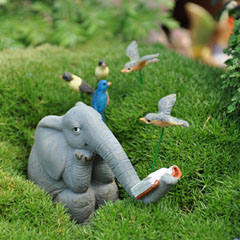Time to Compost the Miniature Garden
 It is another sunshine-filled day in the miniature garden. The miniature plants are showing off their bright green leaves and colorful flowers. The fairy houses look oh-so charming in the afternoon sun. And the fairies and animals? They are up to their old tricks, rummaging through a pile of old books they found in a wheelbarrow.
It is another sunshine-filled day in the miniature garden. The miniature plants are showing off their bright green leaves and colorful flowers. The fairy houses look oh-so charming in the afternoon sun. And the fairies and animals? They are up to their old tricks, rummaging through a pile of old books they found in a wheelbarrow.
Elephant seems to have found one called Composting for Beginners. He is not quite sure what that word means- so he must qualify as a beginner! Flipping through the dusty pages, his eyes suddenly alight on one specific passage. As it turns out, all of the table scraps and yard waste the miniature garden residents have been throwing away can actually be put to good use. That means the bunny’s extra carrots could be composted, as well as all of the leftovers the trolls always toss into the lake. This could make a huge difference in the miniature garden!
Composting is a lot simpler and more accessible than it might seem at first glance. It is also a supremely satisfying way to help the earth and beautify your miniature garden at the same time. Tired of synthetic fertilizers? Composting can help.
To get started with composting outside, a gardener (or miniature garden elephant, as the case may be) must first choose an outdoor compost site that gets between 5 and 8 hours of sun each day. A lidded wood or chicken wire bin will make composting more convenient. You can find manufactured bins at gardening stores and greenhouses too.
What goes into compost? A variety of organic materials. It’s a solid rule of thumb to have a balance of dry (twigs) and wet (coffee grounds) ingredients. When it is balanced, the compost will quickly and healthily break down, creating a high-quality mix that you can add to your miniature garden.
- Dry or green leaves
- Twigs
- Straw
- Weeds before they have gone to seed
- Grass clippings
- Garden debris
- Shredded newspaper
- Shredded paper towel rolls and egg cartons
- Eggshells
- Vegetable and fruit scraps
- Coffee grounds
As with any garden project, there are a few things to note. Do not compost yard waste that has been treated with pesticides, insecticides, herbicides, or fungicides. Do not compost meat, grease, bones, dairy products, diseased plants, or pet waste.
By the time he got to the list of compost materials, all the other miniature garden animals and fairies were crowded around Elephant. A pixie piped up, “You mean we can help clean up the miniature garden, and feed our miniature plants and miniature trees at the same time?”
Yes! Compost, when given the proper ingredients and time to mature, can improve soil structure, making your miniature plants healthier. It provides nutrients for miniature plants and can even prevent harmful pathogens from hurting your plants.
After the miniature garden animals and friends build up their compost pile, they will have to wait a few months for the layers of waste to turn into a moist, dark brown pile. They might be able to spot some earthworms and ground beetles in it, which will help with further decomposition.
Finally, all Elephant (or any miniature gardener) needs to do is add the compost to the miniature garden. Compost can be spread around when planting a new miniature garden or miniature tree. It can be added to indoor and outdoor container gardens. It can be substituted for mulch in a perennial garden. And it can be sprinkled around plants during the growing season. Is there anything that compost cannot do? Perhaps not! That is why so many miniature garden friends, animals, fairies, pixies, and yes, human gardeners swear by the powers of compost. You might want to take a page out of Elephant’s book, and try composting too!
Comments
{{ errors.first("comment") }}


